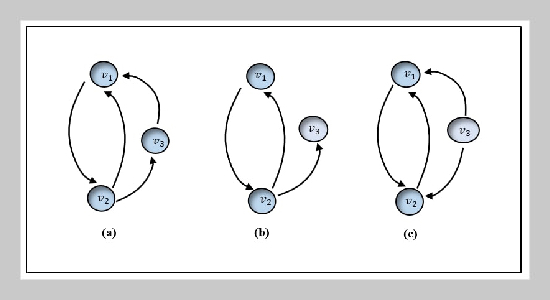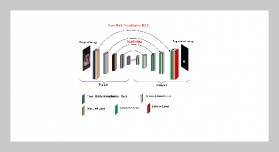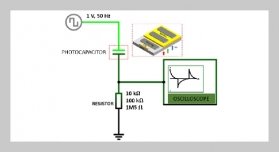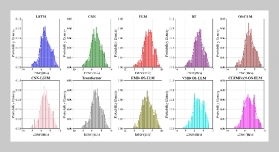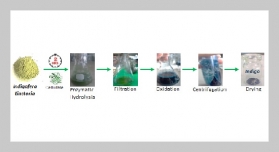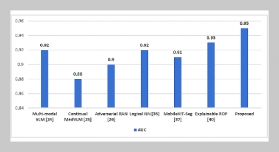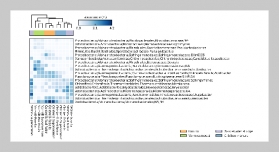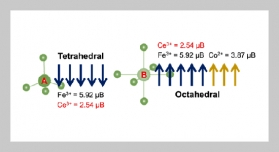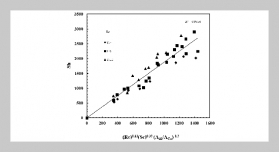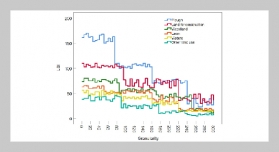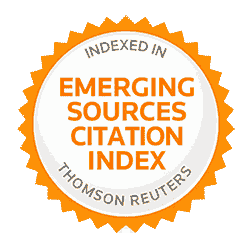- [1] F. Bonomo-Braberman, N. Brettell, A. Munaro, and D. Paulusma, (2024) “Solving problems on generalized convex graphs viamim-width" Journal of Computer and System Sciences 140: 103493. DOI: 10.1016/j.jcss.2023.103493.
- [2] G. Jayabalasamy, C. Pujol, and K. Latha Bhaskaran, (2024) “Application of graph theory for blockchain technologies" Mathematics 12(8): 1133. DOI: 10.3390/math12081133.
- [3] S. M. Kosti´c, M. I. Simi´c, and M. V. Kosti´c, (2020) “Social network analysis and churn prediction in telecommunications using graph theory" Entropy 22(7): 753. DOI: 10.3390/e22070753.
- [4] M. R. Davahli, W. Karwowski, K. Fiok, A. Murata, N. Sapkota, F. V. Farahani, A. Al-Juaid, T. Marek, and R. Taiar, (2022) “The COVID-19 infection diffusion in the US and Japan: A graph-theoretical approach" Biology 11(1): 125. DOI: 10.3390/biology11010125.
- [5] S. Brezovnik, N. Tratnik, and P. Žigert Pleteršek, (2021) “Weighted Wiener indices of molecular graphs with application to alkenes and alkadienes" Mathematics 9(2): 153. DOI: 10.3390/math9020153.
- [6] N. Saleem, R. Shafqat, R. George, A. Hussain, and M. Yaseen, (2023) “A theoretical analysis on the fractional fuzzy controlled evolution equation" Fractals 31(10): 2340090. DOI: 10.1142/S0218348X2340090X.
- [7] K. Abuasbeh and R. Shafqat, (2022) “Fractional Brownian motion for a system of fuzzy fractional stochastic differential equation" Journal of Mathematics 2022(1): 3559035. DOI: 10.1155/2022/3559035.
- [8] K. Abuasbeh, R. Shafqat, A. U. K. Niazi, and M. Awadalla, (2022) “Oscillatory behavior of solution for fractional order fuzzy neutral predator-prey system" AIMS Mathematics 7(11): 20383–20400. DOI: 10.3934/math.20221117.
- [9] K. Abuasbeh, R. Shafqat, A. U. K. Niazi, and M. Awadalla, (2022) “Local and global existence and unique ness of solution for class of fuzzy fractional functional evolution equation" Journal of Function Spaces 2022(1): 7512754. DOI: 10.1155/2022/7512754.
- [10] A. U. K. Niazi, J. He, R. Shafqat, and B. Ahmed, (2021) “Existence, uniqueness, and Eq–Ulam-type stability of fuzzy fractional differential equation" Fractal and Fractional 5(3): 66. DOI: 10.3390/fractalfract5030066.
- [11] M. Khan, S. Ullah, M. Zeeshan, R. Shafqat, I. Kebaili, T. B. Bedada, and S. Anis, (2024) “Novel complex fuzzy distance measures with hesitance values and their applications in complex decision-making problems" Scientific Reports 14(1): 14243. DOI: 10.1038/s41598-024-64112-6.
- [12] M. Zeeshan, M. Khan, R. Shafqat, A. Althobaiti, S. Althobaiti, and T. B. Bedada, (2024) “Novel similarity measures under complex pythagorean fuzzy soft matrices and their application in decision making problems" Scientific Reports 14(1): 17129. DOI: 10.1038/s41598-024 65324-6.
- [13] S.A.Kauffman,(1971)“Cellular homeostasis, epigenesis and replication in randomly aggregated macromolecular systems" Journal of Cybernetics 1(1): 71–96. DOI: 10.1080/01969727108545830.
- [14] A. Rosenfeld. “Fuzzy graphs”. In: Fuzzy sets and their applications to cognitive and decision processes. Elsevier, 1975, 77–95. DOI: 10.1016/B978-0-12-775260-0.50008-6.
- [15] M. Pal, S. Samanta, and G. Ghorai. Modern trends in fuzzy graph theory. Springer, 2020. DOI: 10.1007/978 981-15-8803-7.
- [16] M.Binu,S.Mathew,andJ.N.Mordeson,(2021)“Connectivity status of fuzzy graphs" Information sciences 573: 382–395. DOI: 10.1016/j.ins.2021.05.068.
- [17] U. Ahmad and I. Nawaz, (2022) “Directed rough fuzzy graph with application to trade networking" Computational and Applied Mathematics 41(8): 366. DOI: 10.1007/s40314-022-02073-0.
- [18] X. Shi, S. Kosari, A. A. Talebi, S. H. Sadati, and H. Rashmanlou, (2022) “Investigation of the main energies of picture fuzzy graph and its applications" Interna tional Journal of Computational Intelligence Systems 15(1): 31. DOI: 10.1007/s44196-022-00086-5.
- [19] S. Shanmugam, T. P. Aishwarya, and N. Shreya, (2023) “Bridge domination in fuzzy graphs" Journal of fuzzy extension and applications 4(3): 148–154. DOI: 10.22105/jfea.2023.382170.1251.
- [20] J. Scott and M. Tma. Algorithms for sparse linear systems. Springer Nature, 2023. DOI: 10.1007/978-3-031 25820-6.
- [21] K. Hayashi, S. G. Aksoy, and H. Park. “Skew symmetric adjacency matrices for clustering directed graphs”. In: 2022 IEEE International Conference on Big Data (Big Data). IEEE. 2022, 555–564. DOI: 10.1109/BigData55660.2022.10020413.
- [22] J. Bang-Jensen and G. Z. Gutin. Digraphs: theory, algorithms and applications. Springer Science & Business Media, 2008.
- [23] V. Noferini and M. C. Quintana, (2024) “Generating functions of non-backtracking walks on weighted digraphs: Radius of convergence and Ihara’s theorem" Linear Alge bra and its Applications 699: 72–106. DOI: 10.1016/j.laa.2024.06.022.
- [24] O. U. Qasim, (2022) “Structures of Normed Path-Edge Spaces of Irreducible Fuzzy Graphs" 18(05): 1645. DOI: 10.24507/ijicic.18.05.1645.
- [25] D. Bravo, F. Cubría, M. Fiori, and V. Trevisan, (2023) “Characterization of digraphs with three complementarity eigenvalues" Journal of Algebraic Combinatorics 57(4): 1173–1193. DOI: 10.1007/s10801-023-01218-6.
- [26] D. Grinberg, (2023) “An introduction to graph theory" arXiv preprint arXiv:2308.04512: DOI: 10.48550/arXiv.2308.04512.
- [27] D. Nithyanandham, F. Augustin, D. R. Micheal, and N. D. Pillai, (2023) “Energy based bipolar intuitionis tic fuzzy digraph decision-making system in selecting COVID-19 vaccines" Applied Soft Computing 147: 110793. DOI: 10.1016/j.asoc.2023.110793.
- [28] D. Nithyan and ham and F. Augustin, (2023) “A bipolar fuzzy p-competition graph based ARAS technique for prioritizing COVID-19 vaccines" Applied Soft Computing 146: 110632. DOI: 10.1016/j.asoc.2023.110632.
- [29] D. Nithyan and ham, F. Augustin, S. Narayanamoor thy, A. Ahmadian, D. Balaenu, and D. Kang, (2023) “Bipolar intuitionistic fuzzy graph based decision-making model to identify flood vulnerable region" Environmental Science and Pollution Research 30(60): 125254 125274. DOI: 10.1007/s11356-023-27548-3.
- [30] A. Banerjee and S. Amanathulla, (2024) “Optimization of disaster management using split domination in picture fuzzy graphs" Journal of Applied Mathematics and Computing 70(1): 435–459. DOI: 10.1007/s12190-023-01965-6.
- [31] S. R. Islam and M. Pal, (2023) “Further development of F-index for fuzzy graph and its application in Indian railway crime" Journal of applied mathematics and computing 69(1): 321–353. DOI: 10.1007/s12190-022 01748-5.
- [32] S. R. Islam and M. Pal, (2023) “An investigation of edge F-index on fuzzy graphs and application in molecu lar chemistry" Complex & Intelligent Systems 9(2): 2043–2063. DOI: 10.1007/s40747-022-00896-2.
- [33] S. Broumi, M. Talea, A. Bakali, F. Smar and ache, D. Nagarajan, M. Lathamaheswari, and M. Parimala, (2019) “Shortest path problem in fuzzy, intuitionistic fuzzy and neutrosophic environment: an overview" Com plex & Intelligent Systems 5: 371–378. DOI: 10.1007/ s40747-019-0098-z.
- [34] S. Halder, S. Majumder, A. Biswas, B. K. Mandal, and S.-L. Peng. “On Multi-objective Fuzzy Shortest Path Problem”. In: International Conference on Advances in Data Science and Computing Technologies. Springer. 2022, 499–509. DOI: 10.1007/978-981-99-3656-4_51.
- [35] J. N. Mordeson and S. Mathew. Advanced topics in fuzzy graph theory. 375. Springer, 2019. DOI: 10.1007/ 978-3-030-04215-8.
- [36] E. Enriquez, G. Estrada, C. Loquias, R. J. Bacalso, and L. Ocampo, (2021) “Domination in fuzzy directed graphs" Mathematics 9(17): 2143. DOI: 10.3390/math9172143.
- [37] M. Tom and M. S. Sunitha,(2015)“Strongsumdistance in fuzzy graphs" Springer Plus 4: 1–14. DOI: 10.1186/s40064-015-0935-5.
- [38] S. D. Mohsen and Y. H. Thiyab, (2024) “Some Characteristics Of Completeness Property In Fuzzy Soft b-Metric Space" Journal of Applied Science and Engineering 27(3): 2227–2232. DOI: 10.6180/jase.202403_27(3).0009.
- [39] S. Nadaban, (2023) “Fuzzy quasi-b-metric spaces" Ann. West Univ. Timis. Math. Comput. Sci 8: 38–48. DOI: 10.2478/awutm-2022-0015.
- [40] S. N˘ad˘aban, (2016) “Fuzzy b-metric spaces" International Journal of Computers Communications & Control 11(2): 273–281. DOI: 10.15837/ijccc.2016.2.2443.
- [41] D. Doli´ canin-Ðeki´ c, T. Došenovi´c, H. Huang, and S. Radenovi´c, (2016) “A note on recent cyclic fixed point results in dislocated quasi-b-metric spaces" Fixed Point Theory and Applications 2016: 1–10. DOI: 10.1186/s13663-016-0565-9.
- [42] N. Zikria, M. Samreen, T. Kamran, H. Aydi, and C. Park, (2022) “Some periodic and fixed point theorems on quasi-b-gauge spaces" Journal of Inequalities and Applications 2022(1): 13. DOI: 10.1186/s13660-021 02750-4.
- [43] J. Matoušek. Lecture notes on metric embeddings. Tech. rep. Technical report, ETH Zürich, 2013.
- [44] D. Taha, W. Zhao, J. M. Riestenberg, and M. Strube, (2023) “Normed Spaces for Graph Embedding" arXiv preprint arXiv:2312.01502: DOI: 10.48550/arXiv.2312.01502.
- [45] A. Gu, F. Sala, B. Gunel, and C. Ré. “Learning mixed curvature representations in product spaces”. In: In ternational conference on learning representations. 2018.
- [46] F. Lopez, B. Pozzetti, S. Trettel, M. Strube, and A. Wienhard. “Symmetric spaces for graph embeddings: Afinsler-riemannian approach”. In: International Con ference on Machine Learning. PMLR. 2021, 7090–7101.
- [47] F. Di Giovanni, G. Luise, and M. Bronstein, (2022) “Heterogeneous manifolds for curvature-aware graphem bedding" arXiv preprint arXiv:2202.01185: DOI: 10.48550/arXiv.2202.01185.
- [48] J. Matoušek, (1996) “On the distortion required for embedding finite metric spaces into normed spaces" Israel Journal of Mathematics 93(1): 333–344. DOI: 10.1007/BF02761110.
- [49] J. Matousek. Lectures on discrete geometry. 212. Springer Science & Business Media, 2013. DOI: 10. 1007/978-1-4613-0039-7.


